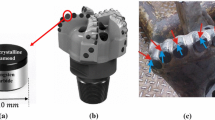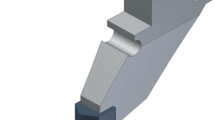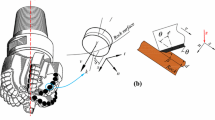Abstract
Digital drilling is a common method for detecting the deep rock mass information, but the cutter wear leads to an irregular shape of the rock chip affecting the detecting accuracy. The detecting methodology lacks the consideration of ground stress and cutter wear. This study developed an analytical model that incorporated confining stress and cutter wear to predict the rock failure surface and required cutting force. Curvature radius is introduced to characterize the failure surface. Triaxial drilling tests were conducted to verify the prediction of the model. The impact of confining stress and cutter wear on the failure patterns was investigated. Failure surface and cutting force were measured to confirm the reliability of the model (approximately 90%). There are two patterns of failure surface, depending on the depth of cut. As the confining stress increases, the predicted cutting force linearly increases, and the curvature radius decreases. Hydrostatic stress has an opposite impact on cutting force and curvature radius, compared to confining stress. This method shows improvement to reduce the sticking phenomenon caused by rock debris.


















Similar content being viewed by others
Data Availability
The data used to support the findings of this study are available from the corresponding author upon request.
Abbreviations
- F t :
-
Thrust force
- F n :
-
Tangential force
- A f :
-
Wear flat area
- β :
-
Wear angle
- d :
-
Depth of cut
- S :
-
Cutting stress
- N :
-
Normal stress
- α :
-
Rake angle of drill bit
- Pp :
-
Pore pressure
- p h :
-
Confining stress
- p d :
-
Hydrostatic pressure
- τ 0 :
-
Shear stress of the crushed zone
- σ 0 :
-
Principal stress of the crushed zone
- γ:
-
Top angle of wedge body of rock
- θ :
-
Included angle between the x axis of the wedge body
- P :
-
The load applied on the wedge
- F fn :
-
Normal component of friction
- F fs :
-
Tangential component of friction
- v :
-
Drilling speed
- w :
-
Rotation speed
References
Akbari B, Miska S, Yu M, Ozbayoglu E (2014) Relation between the mechanical specific energy, cuttings morphology, and PDC cutter geometry. In: International Conference on Ocean, Offshore and Arctic Engineering. Asme International Conference on Ocean, San Francisco, California, USA
Amri M, Pelfrene G, Gerbaud L, Sellami H, Tijani M (2016) Experimental investigations of rate effects on drilling forces under bottom hole pressure. J Petrol Sci Eng 147:585–592
Babaei KM, Hall R (2016) Processing of measurement while drilling data for rock mass characterization. Int J Min Sci Technol 6:989–994
Bayram F, Kulaksiz S (2021) Evaluation of rock cutting performance of diamond segmented frame saw in terms of diamond segment wear. Int J Rock Mech Min 139:104657
Bobet A, Fakhimi A, Johnson S, Morris J, Tonon F, Yeung R (2009) Numerical models in discontinuous media: review of advances for rock mechanics applications. J Geotech Geoenviron (ASCE) 135(11):1547–1561
Carrapatoso CM, Righetto GL, Lautenschlager CER, Fontoura SAB, Inoue N (2015) Numerical modeling of single cutter tests in carbonates. In: US Rock Mechanics/Geomechanics Symposium, San Francisco, CA, USA
Che D, Ehmann K (2014) Experimental study of force responses in polycrystalline diamond face turning of rock. Int J Rock Mech Min 72:80–91
Cheng Z, Li GS, Huang ZW, Sheng M, Wu XG, Yang JW (2019) Analytical modelling of rock cutting force and failure surface in linear cutting test by single PDC cutter. J Pet Sci Eng 177:309–316
Chiaia B, Borri-Brunetto M, Carpinteri A (2013) Mathematical modelling of the mechanics of core drilling in geomaterials. Mach Sci Technol 17(1):1–25
Detournay E, Defourny P (1992) A phenomenological model for the drilling action of drag bits. Int J Rock Mech Min Geomech Abstr 29:13–23
Detournay E, Hakobyan Y (2022) Hydraulic fracturing of weak rock during waterflooding. Int J Numer Anal Met 46(2):416–435
Detournay E, Richard T, Shepherd M (2008) Drilling response of drag bits: theory and experiment. Int J Rock Mech Min 45:1347–1360
Ersoy A, Waller MD (1995) Wear characteristics of PDC pin and hybrid core bits in rock drilling. Wear 188:150–165
Ersoy A, Waller MD (1997) Drilling detritus and the operating parameters of thermally stable PDC core bits. Int J Rock Mech Min Sci 34:1109–1123
Evans I (1984) A theory of the cutting force for point-attack picks. Int J Min Eng 2(1):63–71
Franca LFP, Mostofi M, Richard T (2015) Interface laws for impregnated diamond tools for a given state of wear. Int J Rock Mech Min 73:184–193
Gerbaud L, Menand S, Sellami H PDC bits: all comes from the cutter rock interaction. In: IADC/SPE Drilling, Conference (2006) 21–23 February, Miami, Florida. Society of Petroleum Engineers, USA
Glowka DA (1987) Development of a method for predicting the performance and wear of PDC (polycrystalline diamond compact) drill bits, technical report. Sandia National Labs, Albuquerque, NM (USA)
Goodman REW (1989) Introduction to rock mechanics. Wiley, New York
Gray KE, Armstrong F, Gatlin C (1962) Two-dimensional study of rock breakage in drag-bit drilling at atmospheric pressure. J Petrol Technol 14(1):93–98
Hareland GA (2010) Drilling rate model for roller cone bits and its application. In: Proceedings of the CPS/SPE International Oil & Gas Conference, Held in Beijing, China, p 8–10
He MM, Li N, Zhang ZQ, Yao XC, Chen YS, Zhu CH (2019) An empirical method for determining the mechanical properties of jointed rock mass using drilling energy. Int J Rock Mech Min 116:64–74
He MM, Li N, Yao XC, Chen YS (2020a) A new method for prediction of rock quality designation in borehole using energy of rotary drilling. Rock Mech Rock Eng 53(7):3383–3394
He MM, Zhang ZQ, Zheng J, Chen FF, Li N (2020b) A new perspective on the constant m(i) of the Hoek-Brown failure criterion and a new model for determining the residual strength of rock. Rock Mech Rock Eng 53(9):3953–3967
He MM, Zhang ZQ, Zhu JW, Li N, Li GF, Chen YS (2021) Correlation between the rockburst proneness and friction characteristics of rock materials and a new method for rockburst proneness prediction: field demonstration. J Petrol Sci Eng 108997
Hu XD, Song XZ, Li GS, Shen ZH, Lyu ZH, Shi Y, Zheng R (2018a) An analytical model to evaluate the heating conditions for drilling in hard rock using an innovative hydrothermal spallation method. Appl Therm Eng 42:709–716
Hu XD, Song XZ, Li GS, Shen ZH, Lyu ZH, Shi Y (2018b) Shape factor of the flake-like particle in thermal spallation and its effects on settling and transport behavior in drilling annulus. Powder Technol 335:211–221
Huang J, Zhang Y, Zhu L, Wang T (2016) Numerical simulation of rock cutting in deep mining conditions. Int J Rock Mech Min 84:80–86
Jaime MC, Zhou Y, Lin JS, Gamwo IK (2015) Finite element modeling of rock cutting and its fragmentation process. Int J Rock Mech Min 80(4):137–146
Kaitkay P, Lei S (2005) Experimental study of rock cutting under external hydrostatic pressure. J Mater Process Technol 159(2):206–213
Kalantari S, Hashemolhosseini H, Baghbanan A (2018) Estimating rock strength parameters using drilling data. Int J Rock Mech Min 104:45–52
Kerisel J (1975) Cours De mécanique Des sols. Ecole National Des Ponts Et Chaussées, Paris ((in French))
Kuzin VV, Grigoriev SN, Volosova MA (2014) The role of the thermal factor in the wear mechanism of ceramic tools: Part 1. Macrolevel. J Frict Wear 35(6):505–510
Lhomme T (1999) Frictional contact at a rock-tool interface: an experimental study. M. Sc Thesis. University of Minnesota
Majidi R, Miska SZ, Tammineni S (2011) PDC single cutter: the effects of depth of cut and RPM under simulated borehole conditions. Wiertnictwo, Nafta, Gaz 283–295
Menezes PL, Lovell MR, Avdeev IV, Iii CFH (2014) Studies on the formation of discontinuous rock fragments during cutting operation. Int J Rock Mech Min 71:131–142
Miguélez MH, Zaera R, Molinari A, Cheriguene R, Rusinek A (2009) Residual stresses in orthogonal cutting of metals: the effect of thermomechanical coupling parameters and of friction. J Therm Stresses 32(3):269–289
Mishnaevsky LL Jr (1995) Physical mechanisms of hard rock fragmentation under mechanical loading: a review. Int J Rock Mech Min Geomech Abstr 32(8):763–766
Munoz H, Taheri A, Chanda EK (2016) Rock drilling performance evaluation by an energy dissipation-based rock brittleness index. Rock Mech Rock Eng 49(8):3343–3355
Munoz H, Taheri A, Chanda EK (2017) Rock cutting performance assessment using strain energy characteristics of rocks. Min Technol 126(4):191–199
Richard T, Germay C, Detournay E (2007) A simplified model to explore the root cause of stick–slip vibrations in drilling systems with drag bits. J Sound Vib 305:432–456
Richard T, Dagrain F, Poyol E, Detournay E (2012) Rock strength determination from scratch tests. Eng Geol 147:91–100
Rostami J, Ghasemi A, Gharahbagh AE, Dogruoz C, Dahl F (2014) Study of dominant factors affecting cerchar abrasivity index. Rock Mech Rock Eng 47:1905–1919
Rostamsowlat I (2018a) Effect of cutting tool properties and depth of cut in rock cutting: an experimental study. Rock Mech Rock Eng 51:1715–1728
Rostamsowlat I, Akbarib B, Evans B (2018b) Analysis of rock cutting process with a blunt PDC cutter under different wear flat inclination angles. J Petrol Sci Eng 171:771–783
Rostamsowlat I, Richard T, Evans B (2019) Experimental investigation on the effect of wear flat inclination on the cutting response of a blunt tool in rock cutting. Acta Geotech 14(2):519–534
Rostamsowlat I, Evans B, Sarout J, Rostami J, Kwon HJ (2022) Determination of internal friction angle of rocks using scratch test with a blunt PDC cutter. Rock Mech Rock Eng 55(12):7859–7880
Seliami H, Fairhurst C, Deliac E, Delbast B (1989) The role of in-situ rock stresses and mud pressure on the penetration rate of PDC bits. In: Rock at Great Depth Symposium, Rotterdam
Shankar VK, Kunar BM, Murthy CS, Ramesh MR (2020) Measurement of bit-rock interface temperature and wear rate of the tungsten carbide drill bit during rotary drilling. Friction 8:1073–1082
Teale R (1965) The concept of specific energy in rock drilling. Int J Rock Mech Min Geomech Abstr 2(1):57–73
Timoshenko SP, Goodier JN (1970) Theory of elasticity. McGraw-Hill, New York
Tran-Cong S, Gay M, Michaelides EE (2004) Drag coefficients of irregularly shaped particles. Powder Technol 139(1):21–32
Voyiadjis GZ, Zhou YN (2018) Numerical modeling of frictional contact between a blunt tool and quasi-brittle rock. Rock Mech Rock Eng 52(10):3771–3790
Walsh SDC, Lomov IN, Wideman TW, Potter JM (2014) Size dependent spall aspect ratio and its effects in thermal spallation. Int J Rock Mech Min 70(9):375–380
Wang Q, Qin Q, Jiang B, Li SC (2018a) Upper bound analytic mechanics model for rock cutting and its application in field testing. Tunn Undergr Sp Tech 73:287–294
Wang Q, Gao S, Jiang B, Li S, He M, Gao H, Qin Q (2018b) Rock-cutting mechanics model and its application based on slip-line theory. Int J Geomech 18(5):04018025
Wang GF, Xu YX, Ren HW (2019) Intelligent and ecological coal mining as well as clean utilization technology in China: review and prospects. Int J Min Sci Techno 29(2):161–169
Wang Q, Gao HK, Jiang ZH, Li SC, Jiang B (2020a) Development and application of a surrounding rock digital drilling test system of underground engineering. Chin J Rock Mech Eng 39:301–310
Wang YJ, She L, Zao YF, Cao RL (2020b) Experimental study on measurement of rock strength parameters based on digital drilling technology. Chi J Geo Eng 42(9):1659–1668
Wang HT, He MM, Pang F, Chen YS, Zhang ZQ (2021) Energy dissipation-based method for brittleness evolution and yield strength determination of rock. J Petrol Sci Eng 200:108376
Wang HT, He MM, Zhang ZQ, Zhu JW (2022a) Determination of the constant m(i) in the Hoek-Brown criterion of rock based on drilling parameters. Int J Min Sci Techno 32(4):747–759
Wang SF, Sun LC, Li XB, Wang SY, Du K, Li X, Feng F (2022b) Experimental investigation of cuttability improvement for hard rock fragmentation using conical cutter. Int J Geomech 21:06020039
Wang J, He MM, Yuan ZY, Luo B, Ma YD (2023) Ductile-brittle failure transition of rocks in process of drilling with high confining pressure: model and experiment. J Petrol Sci Eng. https://doi.org/10.1016/j.geoen.2023.211505
Warren TM, Sinor LA (1994) PDC bits: Whats needed to meet tomorrows challenge. Society of Petroleum Engineers, Richardson, TX (United States)
Yaşar E, Ranjith PG, Viete DR (2011) An experimental investigation into the drilling and physico-mechanical properties of a rock-like brittle material. J Petrol Sci Eng 76(3–4):185–193
Zhou YN, Zhang W, Gamwo I, Lin JS (2017) Mechanical specific energy versus depth of cut in rock cutting and drilling. Int J Rock Mech Min 100:287–297
Funding
This study is sponsored by the National Natural Science Foundation of China (Grants No. 42177158, 11902249 and 11872301), Key Research and Development project of Shaanxi Province (No. 2022SF-412), Education Bureau of Shaanxi Province | Scientific Research Plan Projects of Shaanxi Education Department in China (Grant No. 20JS093). Opening fund of State Key Laboratory of Geohazard Prevention and Geoenvironment Protection (Chengdu University of Technology (Grants No. SKLGP2022K005). Open subject of Urban Geology and Underground Space Engineering Technology Research Center of Shaanxi Province (2022KT-01). The financial support provided by this sponsor is greatly appreciated.
Author information
Authors and Affiliations
Corresponding author
Ethics declarations
Ethics approval
The authors declare compliance with ethical standards.
Conflict of interest
The authors declare no competing interests.
Additional information
Publisher’s Note
Springer Nature remains neutral with regard to jurisdictional claims in published maps and institutional affiliations.
Rights and permissions
About this article
Cite this article
Wang, H., He, M., Yuan, Z. et al. Determination of cutting force and failure surface using a blunt cutter under confining condition: analytical modelling. Bull Eng Geol Environ 83, 136 (2024). https://doi.org/10.1007/s10064-024-03613-0
Received:
Accepted:
Published:
DOI: https://doi.org/10.1007/s10064-024-03613-0




